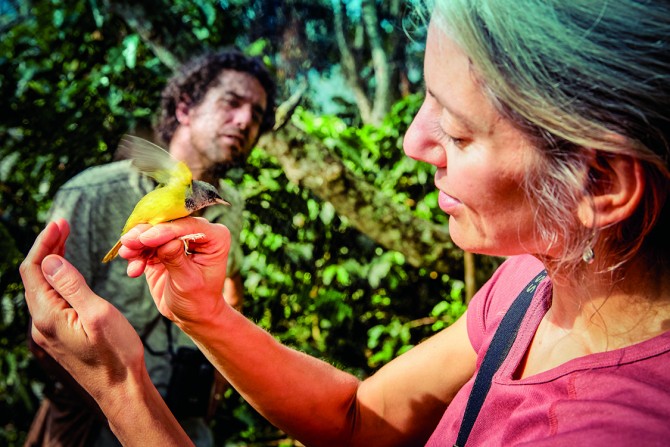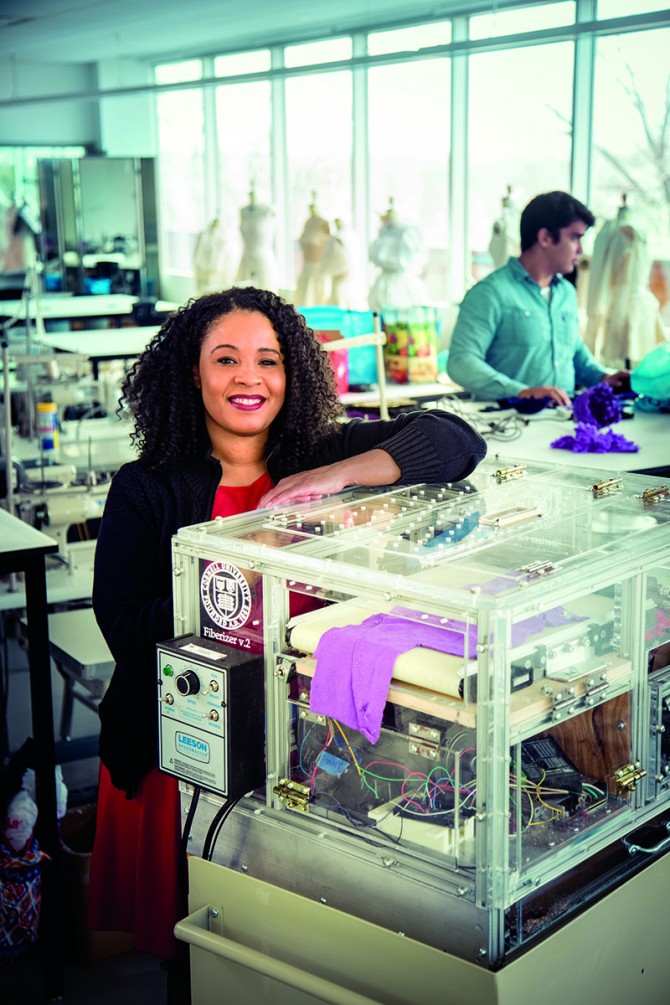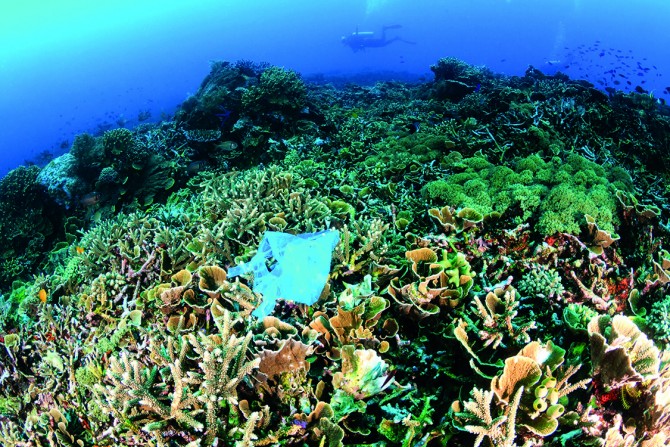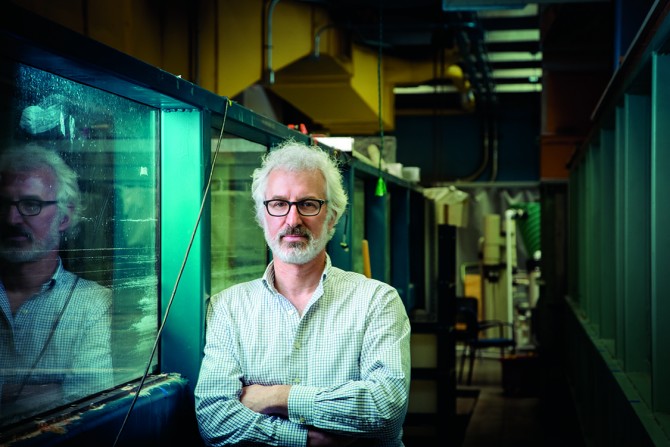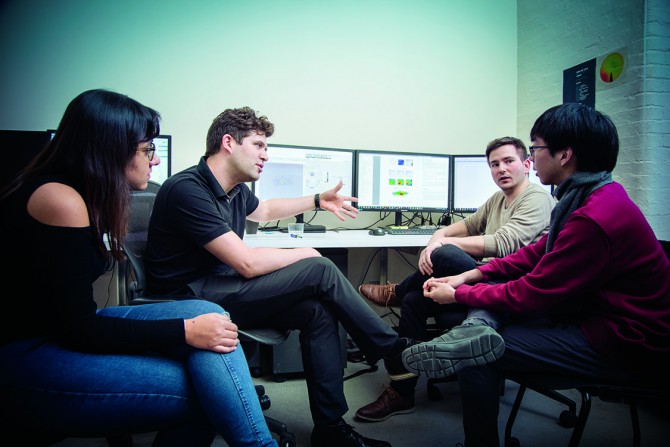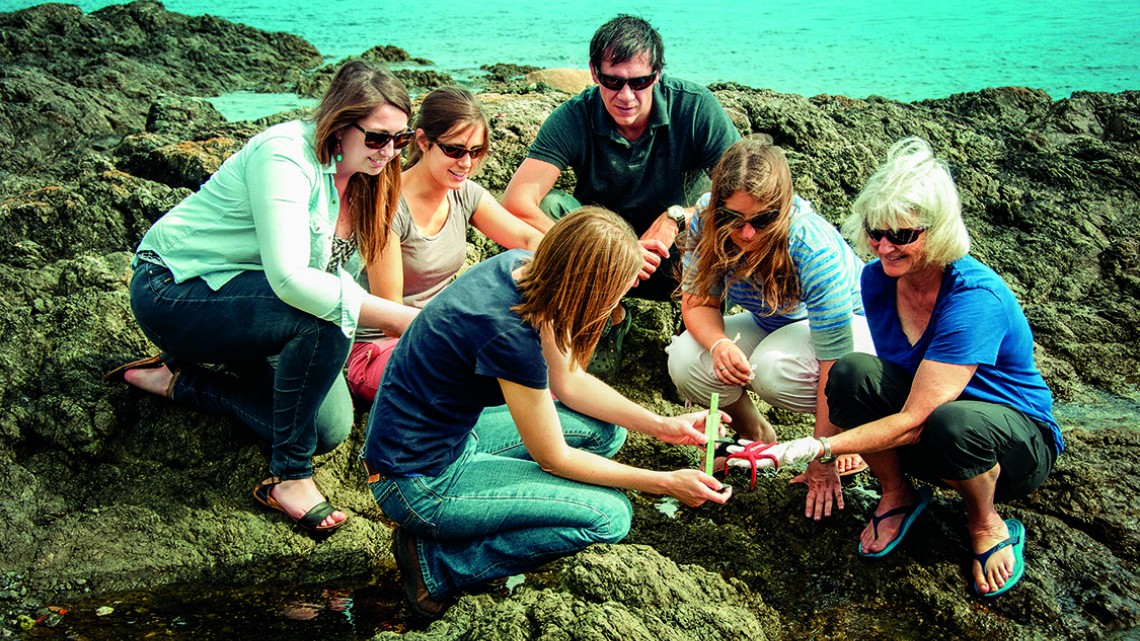
Drew Harvell, far right, professor of ecology and evolutionary biology, examines a sick Pacific blood star with members of the Harvell lab at Friday Harbor Laboratories on San Juan Island, Washington, in 2014.
From ideas to impact: Atkinson Center charts a path to a sustainable future
By David Nutt
Miguel Gómez had a very expensive problem.
Several years ago the economist was working on a multidisciplinary collaboration to explore the connections between birds, soil, production systems and sustainability in direct-trade coffee in Latin America. The team was ready to start its fieldwork and needed to ship soil samples from coffee farms in Colombia to Cornell. The samples were already boxed up. The clock was ticking.
The problem?
“The shipping cost turned out to be super expensive,” Gómez now admits with a laugh. “We were short. And we needed the samples fast. I didn’t know what to do.”
Gómez applied for funding from the Atkinson Center for a Sustainable Future’s Rapid Response Fund, which supports time-sensitive sustainability projects, usually with a price tag under $20,000.
These urgent and emerging projects have included tracking parasitic infections that threaten New York state’s dwindling moose population and capturing vocal recordings of the Javan rhinoceros, one of the most critically endangered species in the world. And, like those projects, Gómez’s funding came through. The soil samples shipped. Gómez, associate professor in Cornell’s Charles H. Dyson School of Applied Economics and Management, is frank about the effect the Atkinson Center support had on the project.
“It saved us,” he says.
Founded as the Cornell Center for a Sustainable Future in 2007 and then named and permanently endowed by David R. Atkinson ’60 and Patricia Atkinson three years later, the Atkinson Center funds multidisciplinary solutions to sustainability challenges throughout the world. The center has more than 500 faculty fellows from across Cornell whose research touches upon crucial sustainability areas such as food, energy, climate, human behavior, the built environment and the interconnections between human, animal and environmental health, known as One Health. The center offers grants and fellowships for researchers, internships for students, and opportunities to collaborate with external partners, from corporations to nonprofits and policymakers, supporting sustainability work that takes risks and bridges disciplines.
Among notable Atkinson-supported projects in its short history:
- Identification of the microbe that caused the mass die-off of sunflower sea stars along the west coast of North America
- A collaboration with the Smithsonian Conservation Biology Institute that resulted in the first puppies born by in vitro fertilization.
- A greater understanding of how climate change’s weakening of the polar vortex leads to severe winter weather outbreaks in the Northern Hemisphere’s middle latitudes.
- Support for Adapt-N, cloud-based computer modeling software that gives farmers precise nitrogen recommendations for their fields, reducing runoff into nearby bodies of water while increasing profitability.
- The development of NutriPhone, a mobile diagnostics platform that monitors and tracks individual vitamin and micronutrient levels quickly and at low cost.
Now, Atkinson leadership is collaborating with its faculty fellows, partners and stakeholders to shape a new strategic plan that will keep the center at the forefront of Cornell’s sustainability efforts, identifying the planet’s most pressing threats and nurturing the solutions that remedy them.
“Building on the tremendous success of the Atkinson Center’s first eight years, and in concert with Provost Michael Kotlikoff’s radical collaboration initiative on sustainability, we are now planning some future investments on topics of great global importance where Cornell can make distinctive contributions working with partner organizations to help drive more sustainable societal practices, products and policies,” says David Lodge, the center’s Francis J. DiSalvo Director. “Emerging themes revolve around rural-urban systems, and include increasing food security, reducing climate risks, accelerating transitions to renewable energy and advancing One Health.” Lodge says the center will be working closely with deans over the next five years to add a new cohort of Atkinson Center-affiliated senior faculty to Cornell to contribute research, as well as educational programs, around these themes.
FACULTY SUPPORT
The soil shipping incident was only one of the ways in which the Atkinson Center has supported Gómez’s research. Gómez, who entered academia as an industrial engineer and economist, credits the center with inspiring him to expand his ideas about how food system supply chains work and delve deeper into linkages with other disciplines – ultimately reshaping his career.
“Cornell is the best place for me because you find experts in all these different areas, in the basic sciences, from genetics to nutrition to environmental sciences, and the center provided us the first support to collaborate,” Gómez says.
But not all projects start out as successes. Gómez’s first Atkinson-funded project, in 2009, sought to assess the sustainability of local and conventional food systems, but the effort never jelled. The topic proved to be too broad, according to Gómez, and there were too many researchers and competing priorities involved.
However, in hindsight, this hardly seems like a failure.
The project introduced Gómez to a handful of kindred researchers, such as Oliver Gao, associate professor of civil and environmental engineering, with whom Gómez soon developed a more focused project: the Enhancing Northeastern Food Security with Regional Food Systems initiative, which was funded by the Agriculture and Food Research Initiative and administered through the U.S. Department of Agriculture’s National Institute of Food and Agriculture. This five-year, $5 million project, which concluded in February 2018, connected researchers from 12 institutions in the Northeast to find opportunities to bring healthy foods produced in the region to underserved communities.
To get an idea of the multiplying effect Atkinson seed grants can have, consider that Gómez’s initial project was launched with $120,000 from the Academic Venture Fund, which is the center’s flagship funding mechanism, and this project paved the way for $5 million in federal funding. This is a prevalent trend among many Atkinson partners and projects. Gómez estimates Atkinson support has multiplied – many times over – the funding he receives from the U.S. Department of Agriculture, the National Science Foundation and other organizations.
FASHION AND BUSINESS PARTNERSHIPS
Sustainability is not always associated with the world of high fashion, but Tasha Lewis, assistant professor of fiber science and apparel design, sees the two as intricately linked. Fashion’s fragmented supply chain leads to tremendous pollution, in the form of water wasted to make textiles, dyes that are not environmentally friendly, the global transportation of goods and the way consumers treat clothing as disposable, depending on whims or trends.
These sustainability issues are a growing concern within the industry, making businesses ideal partners, explains Lewis, whose research aims to reduce waste in the “post-consumer” stage.
“If we can start using our waste to make new products and close that loop, maybe we can make as much as we want because we’re constantly reclaiming it and reusing it and not taking up so many other new resources to make it,” she says.
Lewis first turned to the Atkinson Center when she was seeking rapid-response funding to pair with an Environmental Protection Agency grant to create an equipment prototype for the EPA’s National Sustainable Design Expo in Washington, D.C. The result was the Fiberizer, a machine that shreds old garments into a fibrous mass that can be reused to make new products. A year later Lewis received a Walmart Foundation U.S. Manufacturing Innovation Fund grant to design a newer, more powerful version of the Fiberizer in collaboration with faculty colleague Anil Netravali. Lewis also partnered with clothing brand Eileen Fisher’s Green Eileen recycled apparel division to work on the project.
“Eileen Fisher was very interested in us helping them with their excess textile waste,” Lewis says. “It was really great to know that we’re solving a real-world problem that exists for a lot of companies.”
This type of industry partnership has its own kind of multiplier effect, given the amount of sway a company like Eileen Fisher has among its apparel peers.
“They have the capability to scale it up,” Lewis says. “They have more influence with their peers and their industry circle. It’s something that can actually have legs and go further.”
NGO PARTNERSHIPS
The Atkinson Center’s reach and impact are also amplified by long-term collaborations with nongovernment organizations that have the potential to effect change on a large scale.
For example, in 2015 the center launched a three-year pilot program with the Environmental Defense Fund (EDF) to finance projects that address urgent public health and environmental issues. So far, 13 projects that leverage Cornell’s multidisciplinary research and EDF’s policy expertise have been funded. The projects range from feeding people through sustainable fisheries and farms to reducing methane emissions from industrial sites.
In addition, 18 Cornell undergraduate students have received summer internships with EDF.
One project, “Integrated Approach to Climate Change,” led by Douglas MacMartin, senior research associate and senior lecturer in mechanical and aerospace engineering, is exploring the question of whether to integrate solar geoengineering – a process of reflecting sunlight back into space – with other strategies, such as carbon dioxide removal, to fight climate change. The project is helping shape a growing discussion about geoengineering governance and research needs, with MacMartin testifying before the House of Representative’s energy and environment subcommittees in November 2017.
“As academics, we can engage with people and together identify problems, come up with ideas and test those ideas,” says Alex Travis, professor of reproductive biology in the College of Veterinary Medicine, associate dean of international programs and public health, and an Atkinson faculty fellow, who oversees several of the center’s NGO partnerships. “But to really have impact at scale, you need to either have a commercial partner who can change their practices, roll out a sustainable product, work with an NGO that can help change human behavior or work with government to change policy.”
Adam Seth Levine, associate professor in the Department of Government, agrees that changing public policy and changing individual behavior are two critical pieces of the solution to unlocking a more sustainable future.
“Truly novel ideas for doing so require regularly convening a diverse set of people who bring a wide range of knowledge and cognitive tools to the table,” Levine says. “That’s precisely what the Atkinson Center does, and it’s important, irreplaceable and impactful.” Levine’s AVF project created a networking site that connects people from the academic, nonprofit and government sectors who are interested in collaborating.
Another collaboration, with the Smithsonian Conservation Biology Institute, has generated insight into a fungal disease that is destroying amphibians, as well as the application of genomics to endangered canids, like the African painted dog.
One advantage of maintaining multiple collaborations is the ability to share resources and knowledge in fresh, often unexpected, ways. For instance, when EDF and Smithsonian began working in Myanmar, the Atkinson Center connected the two institutions.
“Even though Cornell and EDF were starting a new project together, Smithsonian was happy to help and share 20 years’ worth of data and their understanding and connections,” Travis says. “So these connections actually build and provide synergy between our partners as well.”
POSTDOCTORAL SUPPORT
Other key Atkinson partners include CARE and The Nature Conservancy (TNC), the latter of which proved to be essential, along with EDF, in providing postdoctoral support for marine ecosystems expert Drew Harvell’s research into ocean health.
In 2014 Harvell was joined by Joleah Lamb, who came to Cornell through the NatureNet Science Fellows Program, a partnership between TNC and a number of leading research universities that supports early career scientists working at the intersection of conservation, business and technology. Lamb’s two-year stint as a fellow was dedicated to studying infectious disease in coral reefs around Indonesia’s Spermonde Islands. After the fellowship ended, she received additional support from an EDF-Atkinson grant through the Innovation for Impact Fund.
Lamb has since been the lead author of two papers published in Science in the last year – one concerning the way seagrass can improve polluted seawater by reducing bacterial exposure for corals, the other about the devastation caused when plastic debris activates new infectious disease on coral reefs. Both papers grew out of Atkinson-funded surveys.
“Joleah is the dream postdoc,” Harvell says. “She’s accomplished everything we could ever hope for, in terms of coming in with very strong expertise, but also an incredible capability to collaborate and bring research teams together.”
Postdocs have come to play a more integral part in Atkinson research in recent years, which isn’t much of a surprise to Harvell. When she served as the center’s faculty director for environment from 2009-13, she saw the potential of drawing more postdocs into the fold and proposed the idea to the rest of the Atkinson leadership.
“That’s something I thought was a vital vision for how the Atkinson Center was going to be able to develop the kinds of collaborative projects it was interested in,” Harvell says.
In addition to graduate and postdoc opportunities, the center also has been increasing its efforts to involve more undergraduate students, whether through sustainability-related student research teams with Cornell partners like AguaClara and Shoals Marine Laboratory or assisting faculty in Academic Venture Fund projects through additional funding from the Office of Engagement Initiatives. And there are AVF projects like Imagining Energy Futures, led by associate professor of comparative literature Anindita Banerjee and Albert George, professor of mechanical and aerospace engineering, in which undergraduates from radically different disciplines teamed up to present bold new visions of a world beyond fossil fuels.
As for the evolution of her own research, Harvell credits the Atkinson Center with enhancing her relationships with EDF and TNC and also inspiring her to embrace policy-related issues. In 2014, she helped U.S. Rep. Denny Heck (D-Wash.) craft a proposed Emergency Marine Disease Act that would develop a rapid-response plan for addressing underwater disease outbreaks, and she also writes op-eds for The Hill.
“I don’t think I would’ve taken on some of the policy implications of our work without the awareness that’s been fostered by the Atkinson Center,” Harvell says. “It has been a cultural shift for me.”
BENEFITING THE PEOPLE OF NEW YORK
Of course, there’s no better way to help shape policy than by working directly with policymakers. The Atkinson Center has partnered with Avangrid (the parent company of New York State Electric and Gas Corp.), BMW North America, Tesla, Distributed Sun and Cornell Cooperative Extension of Tompkins County to work with New York state to develop a pilot program for new residential electric storage systems that allow consumers to better control their energy use through smart meters and an online energy manager.
These “smart” systems have the potential to make power grids more flexible, integrate distributed renewable energy sources, lower household electricity costs and help cut greenhouse gas emissions.
The Energy Smart Community project, which is part of New York state’s Reforming the Energy Vision initiative and is also funded by a $1 million grant from the National Science Foundation, is led by Todd Cowen, the Kathy Dwyer Marble and Curt Marble Faculty Director for Energy at the Atkinson Center.
Cowen taps not only Cornell’s energy and engineering expertise for the project, but also experts in the social sciences who specialize in energy and behavioral economics with the goal of understanding what will motivate consumers to embrace smart energy solutions.
After it is launched in Ithaca, the Energy Smart Community prototype will be rolled out to 1.4 million customers across NYSEG and Rochester Gas and Electric, also owned by Avangrid, starting as early as 2019.
But the project has the potential to reach far beyond New York. Avangrid itself is owned by Iberdrola, a Spain-based multinational company that operates on three continents, which means this prototype project will likely shape the future of the company’s smart grid projects, Cowen says.
In the meantime, Cowen and his team also are making inroads with New York state policymakers – specifically the New York Public Service Commission and New York State Energy Research and Development Authority.
“To me, it’s more reasons to experiment,” Cowen says. “You have to do experiments to succeed.
“And in a larger sense, this is how I see the Atkinson Center,” he continues. “I’ve been involved since its inception, and our success has exceeded my wildest expectations. As we finalize our new strategic plan, I am confident the Atkinson Center and its impact worldwide will just continue to grow.”
Media Contact
Get Cornell news delivered right to your inbox.
Subscribe



